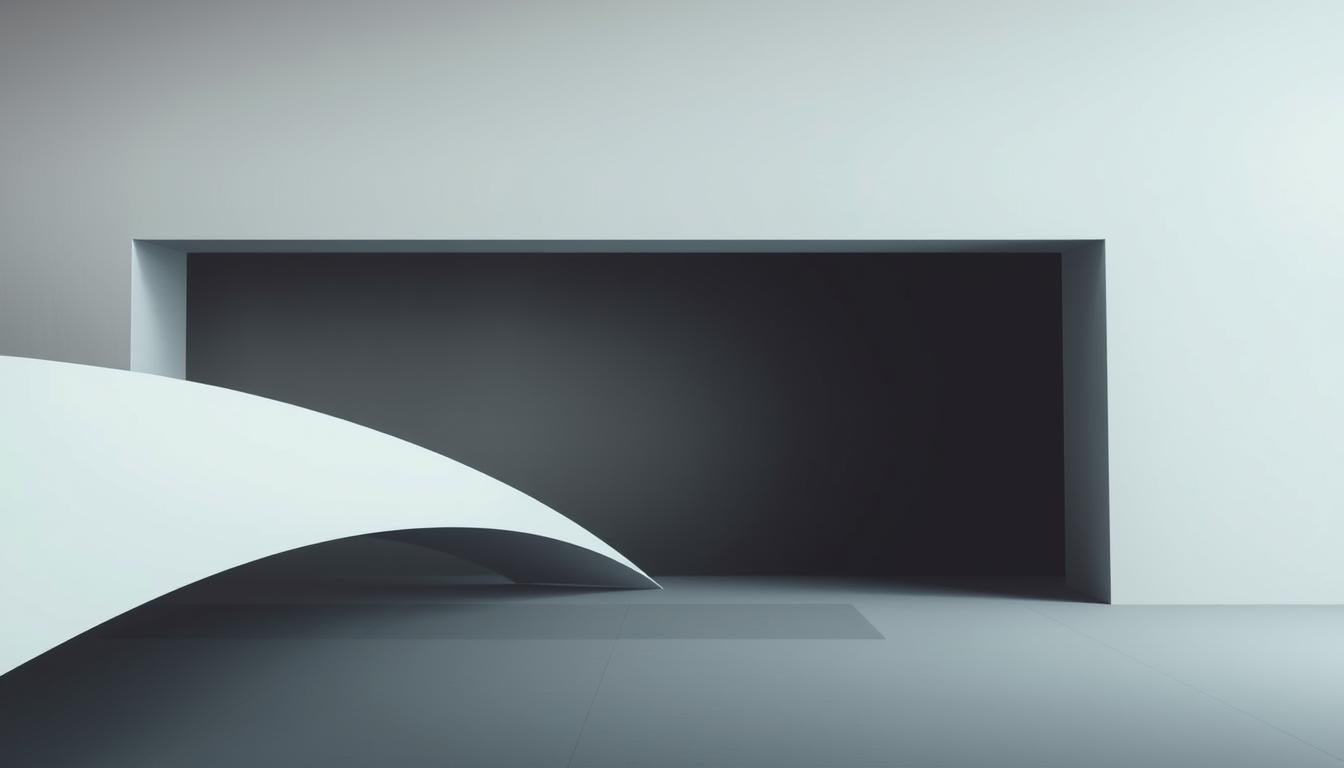Can a square or a strip of light change how you see modern art? That question sits at the heart of a bold idea: art that refuses to imitate and instead exists on its own terms.

Born in the United States in the 1960s, minimalism reduced forms to simple geometry and clear lines. Pioneers like Frank Stella, Donald Judd, and Agnes Martin pushed the notion that the viewer must meet the work directly, free of narrative or illusion.
In this guide we will decode the core principles, trace the movement’s roots in abstraction and conceptual thought, and show why simplicity and order still matter in design and culture today.
Key Takeaways
- We’ll explain what the term means and how it reshaped modern art.
- Learn the basics: origins, materials, and signature artists.
- See connections to conceptual trends and earlier abstraction.
- Find examples and museum references to recognize key works.
- Understand the craft behind stripped-down forms and their lasting appeal.
- Explore further context at the Tate’s overview of minimalism: minimalism.
What Is Minimalism in Art? Defining the minimalist art meaning
Artists in New York began stripping away illusion to let materials and form speak plainly.
Minimalism rejects representation. It asks viewers to meet the object itself—its surface, edges, and scale—without narrative or symbolism.
“What you see is what you see.”
“What you see is what you see.”
Early painting, like Stella’s Black Paintings at MoMA, turned from expressive brushwork typical of abstract expressionism toward exact lines and flat surfaces.
From reduction to literal presence
Look for geometric shapes, repetition, equality of parts, and neutral surfaces. These features make the work a literal presence rather than a depiction.
Donald Judd’s idea of “Specific Objects” bridged painting and sculpture. His works occupy space as literal forms, focusing attention on proportion, interval, light, and edges.
| Feature | What to look for | Example |
|---|---|---|
| Surface | Neutral, industrial finishes | Stella’s enamel on canvas |
| Form | Geometric forms and repetition | Judd’s stacks |
| Presence | Objecthood over illusion | Flavin’s light installations |
Origins and Evolution: From late 1950s roots to the 1970s art world
By the late 1950s a new visual logic began to replace gesture with geometry in New York studios.
Turning away from Abstract Expressionism
Frank Stella’s Black Paintings at MoMA in 1959 signaled a clear move away from abstract expressionist drama. Artists favored clarity, even surfaces, and repeated shapes over gesture.
New York as a hub
Galleries and museums in New York amplified the change. The Green Gallery showed Judd and Dan Flavin in 1964. Leo Castelli and Pace promoted geometric paintings and works by younger artists.
Two 1966 shows crystallized the movement. Primary Structures at the Jewish Museum introduced American and British sculpture. Systemic Painting at the Guggenheim mapped shaped canvas and hard-edge practice.
Figures such as Sol LeWitt, Donald Judd, Carl Andre, Robert Morris, and Stella shaped the scene. Curators, critics, and institutions turned studio experiments into a defining chapter of modern art.
"What you see is what you see."
- Bridge to Conceptual and postminimal practices: reduced forms opened paths to rules, process, and site-aware work.
- Industrial materials and structure: English-language access to Russian avant-garde ideas pushed an interest in materials and essential construction.
Core Principles of Minimalist Art
Reduction focuses attention: stripped shapes and measured intervals reveal how objects occupy space.
Reduction, order, and harmony
Reduction pares visual information until proportion, interval, and form become unmistakable.
Order and harmony come from modules, grids, and exact spacing. These structures feel stable and measured.
Agnes Martin used subtle grids to make quiet, contemplative order visible.
Repetition and equality of parts
Repeating units create rhythm. Equality of parts lets small differences stand out across a field.
Neutral surfaces and industrial finishes reduce the artist’s gesture so the object leads the experience.
These ideas operate across painting and sculpture—from measured grids and flat painting to modular stacks and floor pieces.
- Conceptual clarity: focus on literal objecthood over illusion.
- Disciplined craft: precision in proportion and choice of materials matters.
Materials, Methods, and Forms
Many postwar makers turned to factory-made parts and precise joins to sharpen visual clarity.
Industrial materials and finishes
Aluminum, fluorescent light, and fiberglass supplied smooth, neutral surfaces and crisp edges. These industrial materials let the viewer focus on form and spacing rather than brushwork or symbolism.
Fabrication and modular logic
Artists used modular construction, serial production, and shop-made parts to reduce visible handwork. The result was consistent modules and exact spacing across multiple works.
- Precision fabrication produced equal parts and repeated structures.
- Serial modules made proportion and rhythm central to the viewer’s experience.
Specific objects and placement
Donald Judd’s stacks and boxes show how consistent modules and industrial finishes create literal objects with strong spatial presence. Dan Flavin used off-the-shelf tubes to change space with measured intervals of light.
Installation matters: alignment, height, and relation to wall or floor shape how a work meets the viewer. Notice joints, fasteners, and finishes in museums—these details reveal the industrial DNA behind the work.
For more background on the movement’s methods and history, see a concise overview at this summary.
Minimalist Artists and Iconic Works
A handful of artists transformed basic shapes and industry-made parts into works that reshape a room.
Donald Judd: Untitled stacks and Specific Objects
Donald Judd advanced the idea of Specific Objects with modular stacks and boxes. His pieces use industrial fabrication, even spacing, and exact finishes to make wall height and depth part of the composition.
Dan Flavin: Fluorescent light installations
Dan Flavin used off-the-shelf fluorescent tubes to bathe corners and walls in color. These light works change how viewers sense space and surface.
Frank Stella: Black Paintings and hard-edge rigor
Frank Stella moved painting toward precise stripes and shaped canvases. The Black Paintings at MoMA stripped gesture and emphasized crisp structure.
Agnes Martin: Grids, nuance, and contemplative order
Agnes Martin drew fine pencil grids and soft washes. The result is rhythm and calm that rewards close looking.
Robert Morris, Carl Andre, and Tony Smith
Robert Morris used mirrored cubes and large forms that engage the viewer’s body. Carl Andre laid modular floor pieces, like 144 Magnesium Square (1969), to shift weight and movement.
Tony Smith turned pure geometry into room-defining sculpture with works such as Free Ride (1962) and Die.
"What you see is what you see."
- Common thread: industrial materials and precise fabrication unify these artists’ practices.
- Look for: consistent modules, exact intervals, and how each work organizes space.
- Explore related famous works and artists to see these strategies in context.
Influences and Lineages
Early 20th‑century experiments in Europe planted the formal seeds that later flourished in New York.

Constructivism, Suprematism, and De Stijl
Suprematism and De Stijl offered pure geometric shapes and strict balance. Artists like Malevich and Mondrian pared composition to essentials.
Russian Constructivism added engineered structure and a focus on materials. These ideas pushed toward objecthood and factory methods.
Bauhaus legacies and color theory lineages
The Bauhaus promoted material honesty, clear proportion, and color systems for design and paintings.
Those lessons made industrial finishes and exact spacing feel natural to later makers who sought order over gesture.
Zen, ‘nothingness,’ and the contemplative turn
Eastern philosophies influenced quieter practices. Agnes Martin used faint lines and subtle grids to invite still attention.
Sol LeWitt’s rule‑based systems show how structure can replace expressionism with thoughtful order.
"What you see is what you see."
- European reduction, Bauhaus clarity, and contemplative practice combined across the century.
- Access to avant‑garde theory in English helped these currents reach New York and shape materials, form, and work.
Experience and Debate: How viewers meet minimalist works
Encountering reduced structures often begins as a bodily experience rather than an intellectual one.
Scale, placement, and spacing make many works demand movement. A viewer will step closer, circle, or pause. That motion changes how surfaces, light, and edges register in the room.
The viewer’s body, space, and “theatricality”
Michael Fried argued in 1967 that such pieces relied on the spectator’s presence, creating a staged event he called “theatricality.”
“Theatricality” pointed to art that needed time and the body to complete it.
Meaning beyond the obvious: simplicity as complexity
Robert Smithson countered that awareness of viewing conditions is productive, not a flaw. He and others held that the viewer’s role reveals the work’s spatial logic.
Look to Robert Morris’s mirrored cubes and large forms. Reflections, edges, and volume invite participation and alter perception as you move.
Viewing tips: try multiple distances, note light changes, count intervals, and observe how your motion alters the piece’s effect.
| Aspect | Why it matters | Example |
|---|---|---|
| Scale | Invites bodily movement and shifts perspective | Large floor pieces by Robert Morris |
| Placement | Defines how a work meets the room and viewer | Wall-mounted stacks that use height |
| Surface & reflection | Engages viewer through mirrored or neutral finishes | Mirrored cubes that include the viewer in the scene |
The debate remains vital in the art world. Critics and makers sharpened our sense of objecthood, showing that simple structures can hold deep complexity.
Minimalism Today: Contemporary art, design, and museums
From museum galleries to modern interiors, reduced forms remain a visible presence in visual culture. Their clear shapes and calm palettes suit contemporary spaces and echo architectural lines in homes and offices.
From galleries to interiors: Contemporary appeal in the United States
Simplicity, order, and clean geometry align with modern design values. Designers borrow intervals, neutral surfaces, and industrial materials to create calm interiors and crisp product work.

Large gallery installations show scale, light, and repetition so the viewer can grasp spatial relations. Public collections mount these works to preserve their demanding presence.
Where to see it now: MoMA, Tate, and major collections
Key museums such as the Museum of Modern Art in New York and Tate keep formative pieces on view. Works by Donald Judd, Dan Flavin, Frank Stella, Carl Andre, Agnes Martin, and Robert Morris anchor the story worldwide.
- Galleries and museums present large-scale pieces to reveal light, interval, and surface.
- Influence extends to branding, user interfaces, and interiors—showing how museum ideas shape everyday design.
- Take time as a viewer: note reflections, count intervals, and track how space alters a work’s presence.
Conclusion
, A focus on objecthood and precise geometry changed how viewers move through space. This art movement pushed painting and sculpture toward literal presence and clear structure.
Look for repeated units, equality of parts, clean industrial finishes, and exact intervals. Those features make works feel like measured events rather than depictions.
Key figures and artists from the mid 20th century to the present tied these ideas to museum practice. Over time, those choices influenced galleries, interiors, and how we read shapes in a room.
When you visit MoMA, Tate, or a local gallery, take time to stand, step, and count. Rigorous simplicity keeps rewarding viewers and artists across the century.
Enhance Your Space with Unique Modern Masterpieces by Chiara Rossetti
Are you inspired by the innovative mediums and conceptual depth highlighted in our exploration of contemporary art? You’re not alone! Today’s art enthusiasts are seeking cultural relevance and emotional connections in their artwork. However, finding pieces that resonate with modern themes and fit your unique style can be a challenge. That’s where we come in!
At Rossetti Art, we specialize in canvas prints, original paintings, and modern sculptures that celebrate the spirit of now. Each piece created by Chiara Rossetti brings a personal touch that connects deeply with current social narratives—just like the modern masterpieces discussed in the article. Don’t miss out on the chance to elevate your home decor with breathtaking artwork that speaks to your values and aesthetic. Explore our collection today and find your perfect piece! Act now, and transform your space into a gallery of inspiration!
FAQ
What does minimalist art focus on?
It emphasizes reduction: clean forms, limited color, repeated units, and the object itself rather than narrative or symbolism. Works often foreground form, space, and materials so viewers attend to presence and structure.
How did this movement emerge in the late 1950s and 1960s?
Artists reacted against Abstract Expressionism’s layered gesture and personal drama. In New York, galleries like Castelli and museums such as MoMA and the Jewish Museum helped showcase pared-down work that favored industrial processes and geometric clarity.
Which artists define the period and what did they make?
Key figures include Donald Judd with stacked boxes and specific objects, Dan Flavin using fluorescent light, Frank Stella’s early black paintings and hard-edge work, Agnes Martin’s grids, Robert Morris and Carl Andre with modular floor pieces, and Tony Smith’s large geometric sculptures.
What materials and methods are common?
Creators turned to industrial media like aluminum, steel, fluorescent tubing, and fiberglass. Techniques often remove obvious maker’s touch, using fabrication, repetition, and precise geometry to stress objecthood and scale.
How does the viewer’s body factor into these works?
Scale, placement, and repetition create bodily and spatial encounters. Some pieces invite movement around or across them, changing perception and revealing subtle shifts in light, shadow, and proportion.
Is there a philosophical or historical lineage behind this work?
Yes. Lineages include Constructivism, De Stijl, Suprematism, and Bauhaus ideas about form and function, along with Eastern aesthetics such as Zen that value restraint and contemplative emptiness.
How did critics respond at the time?
Responses were mixed. Some praised clarity and order, while others, like Michael Fried, critiqued theatricality and viewer interaction. Debates centered on authorship, objecthood, and whether reduction equaled depth.
How does this movement connect to Conceptual and Postminimal practices?
The focus on idea, process, and dematerialization helped bridge to Conceptual art. Many practitioners explored systems, seriality, and industrial production—opening paths to postminimal experiments with materials and site.
Where can I see representative works today?
Major museums with strong holdings include MoMA in New York, Tate Modern in London, and several contemporary collections in the United States. Regional museums and university galleries often show site-specific or installation works as well.
How does this legacy influence contemporary design and interiors?
The aesthetic of restraint and clarity informed modern design, architecture, and interiors. Clean lines, neutral palettes, and functional forms in furniture and spaces reflect the movement’s emphasis on order and simplicity.







Leave a comment
This site is protected by hCaptcha and the hCaptcha Privacy Policy and Terms of Service apply.